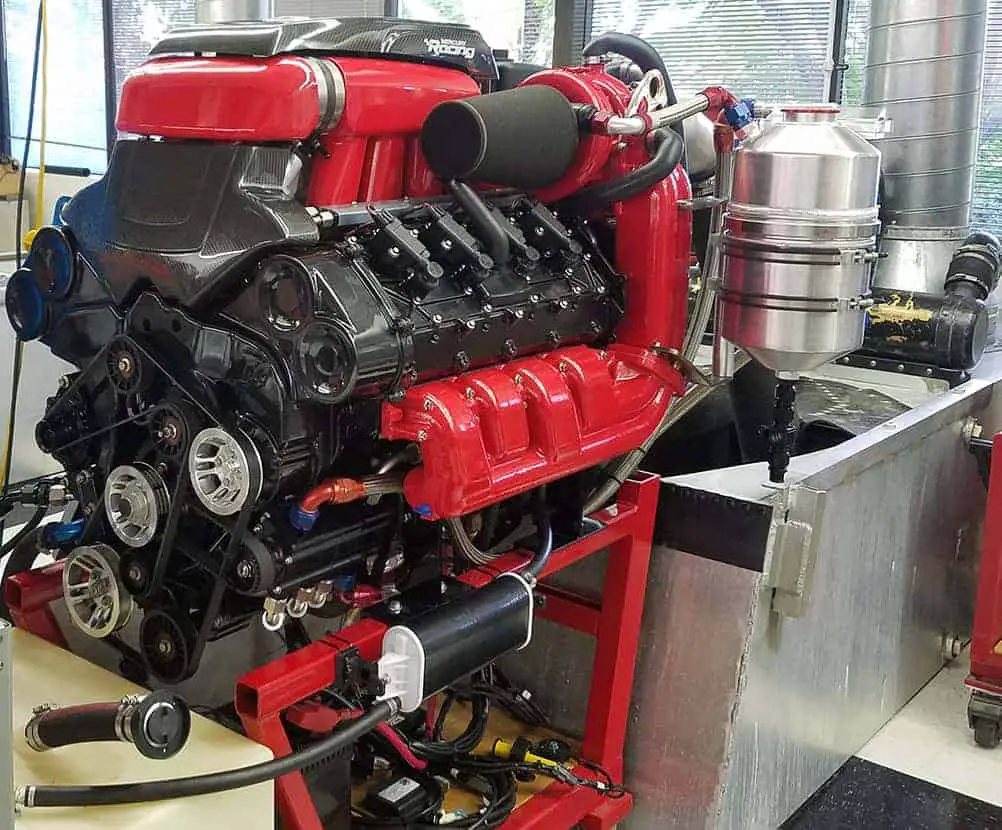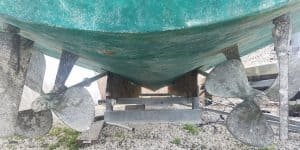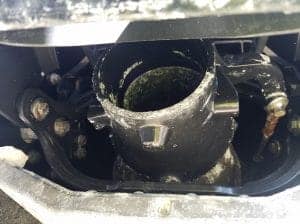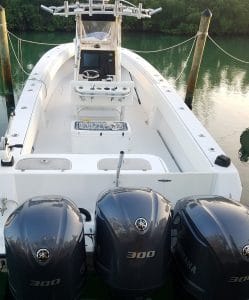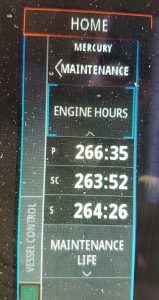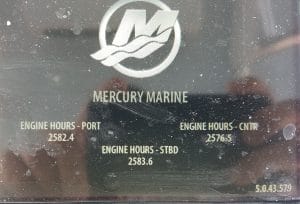If you are new to the boating world, you have probably noticed that some boats have engines on the back, and others you don’t see the engine.
You have probably wondered which one is better and what’s the difference? Don’t worry, we are here for you!
Inboard Vs. Outboard Motor: What’s Right For You? Inboard engine boats are better suited for performing water sports. As well as powering large vessels that require a lot of horsepower to move the boat. Outboard engine boats are better suited for shallow water, salt water, and pontoon boats.
This article is going to tell you what the difference in performance, maintenance, longevity, and driveability is between these different engines.
What Powers a Boat?
Boats have motors or engines. Which, technically a motor is run by electricity and an engine is run by combustion and fire.
In the general world, these words are used interchangeably. The engine that you find in a boat has the same basic functions as a car’s engine.
They are just “marinized” in order to combat the effects that water has on metal and the other components that run the engine.
So, you could say that a boat is powered by a car engine that has been transformed to work in the marine industry.
In some cases, I have seen engines taken out of cars and used to power boats.
In the early days of boating, a lot of the inboard engines that were found in boats, were formed from the blocks or powerheads of General Motors engines. (Here is an article we wrote that will explain all about What Exactly Is An Outboard Powerhead!)
What is an Inboard?
An inboard engine is basically an engine that is inside the boat.
Whereas an outboard has the engine on the outside of the boat, attached to the transom of the boat. (We’ll talk about that in detail in a little bit.)
Whether it be an inboard or an outboard, there are a couple of different components that make up the engine system of a boat.
Unlike our cars which have wheels that the engine turns in order to move the car.
Boats utilize a different type of wheel. They use a propeller. Which requires some changing in order to move the propeller.
The engine itself is built up of the powerhead, (click on the link above for an article we wrote on the break down of an outboard powerhead.)
The powerhead is attached to a driveshaft, which is part of a drive system that turns the propeller.
(And if you have spent enough time on the water you know, that eventually we all hit ground! Here’s some useful information that we posted about talking about Whether or Not You Can Repair a Bent Propeller, or if you have to replace it!)
A boat uses the propeller to move either forward or backward. The drive system gives the operator the ability to move the propeller in either a clockwise motion or a counter-clockwise motion.
Then by turning the direction of that propeller to the right or left, it will propel the boat in either direction you turn it.
For an inboard engine, that engine is bolted into the boat in either the middle of the boat or at the back of the boat.
The drive system is what changes the different types of engines that a lot of people use as interchangeable words as well.
When they really aren’t. They are all extremely different types of inboards that will make the boat perform differently depending on what you have.
The Three Types of Inboards
There are three general types of inboards. Which is referring to the drive system that is changed. They have a couple of different names but are used (incorrectly) interchangeably.
These systems are built up of True inboards, Inboard/Outboard or I/O’s for short, but are also called sterndrives, and then we have the jet drives.
All of these drive systems are referred to under the all-inclusive title of inboards. Which sometimes people will call them I/O’s or sterndrives using the terms loosely.
The Inboard category is then broken down into the three classes of drives being the true inboards, I/O’s or sterndrives, and the jet drives.
What is a True Inboard?
Boats that come with true inboards are boats that utilize one of either two different drive systems.
They can have the engine placed at either the middle of the boat or in the back of the boat.
Remember that the engine is different than the drive system of the boat.
So, when we say engine we are talking about the actual engine and not the drive system which you can think about as the propeller to make it easy.
These two systems are made up of either a Direct Drive 0r D-Drive for short and a V-Drive.
The Direct Drive Inboard has the engine placed in the middle of the boat and has a shaft that comes directly out the back of the engine.
Then utilizes a transmission to send a shaft down into the water with the propeller on the end of the shaft.
The V-Drive system has the engine in the back of the boat and has the shaft coming out of the front of the engine.
Which then has a transmission that makes a “V” and heads out the bottom of the boat placing the propeller on the end of that shaft.
Both of these systems use a transmission that is placed on the inside of the boat in order to change the direction that the propeller is spinning.
These systems then have a rudder that is placed behind the propeller to change the direction of the water flow coming off the propeller from left to right.
The rudder turns the boat in the direction that you want it to go.
What is an Inboard/Outboard (I/O) or Sterndrive?
Next, we have the I/O’s or Sterndrives. These inboards have the engine placed most commonly at the back of the boat.
They use a drive system that goes through the back of the transom of the boat.
This drive system is made up of the upper and lower units. Which is basically the transmission system for the boat.
The upper unit consists of what is required to change the spinning motion of the engine from being horizontal to being vertical, which will transfer the spinning motion down to where it can turn the propeller.
Once this spinning motion is transferred down to the lower unit; the lower unit is able to change the direction of the propeller back and forth from clockwise to counter-clockwise.
Which, in turn, pushes the boat forward or pulls it backward.
This type of drive system does not have a rudder like the true inboards.
Instead, this has the ability to turn the entire drive system either left or right in order to move the boat in which direction you want it to go.
They also have the ability to trim the drive system up, which can push more of the boat out of the water and allow you to have a higher top speed than you can with a true inboard.
Whereas, a true inboard does not have the ability to trim up or down.
What About Pods?
There is one other style of drive system that is considered an I/O but not necessarily a sterndrive. This is because it is a “pod” system that is placed directly on the bottom of the boat.
The sterndrive has the drive system attached to the transom or the stern of the boat and the pod is attached to the bottom of the boat.
The pod system has basically the same exact concept and design as the I/O or sterndrive system. With the exception of being more of a “pod” that is attached to the bottom of the boat.
What is a Jet Drive?
This brings us to the last style of drive system that inboard boats have. Which is the jet drive.
Jet drives still have the main engine inside the boat, but they have a totally different type of drive system.
These drives suck in water from underneath the boat and then use an impeller to create a water jet system.
This forces rapid amounts of water out of the jet pump which will push or pull the boat through the water.
There are a lot of these systems and boats available on the water. But they are a little less common for most boaters. The systems have advanced over the years and are great for going in super shallow water.
The most common example for this is a jet ski. They are super fast and effective on a jet ski. It’s just that they consume a lot of horsepower.
And when pushing a larger boat, they don’t have the same amount of power that you do with the conventional propeller propulsion systems.
Inboard Cooling Systems
It is important to take a minute here to explain the water cooling systems that can be found on inboard engines. It does affect the maintenance department with these cooling systems.
There are two main cooling systems. Closed cooling and raw water cooling.
Try not to get confused here by the names, because they both use raw water or water from outside of the boat, to cool down the engine.
A closed cooling or loop system is based on the same system as a car which has a radiator.
Your car’s radiator gets cooled by air, whereas the boat’s engine, needs to utilize the body of water that it is floating in.
The closed loop cooling system has what is called a heat exchanger.
Which, in a quick explanation, has tubes inside of it that separate the water from outside the boat and the coolant that is used to cool down the engine.
There is a cooling system that runs around the engine cooling it down and that fluid then runs through the heat exchanger.
Inside the heat exchanger, there are also water passages that run water from outside the boat through the heat exchanger.
This allows the water from outside the boat to draw the heat off of the coolant that is flowing around the engine.
Then that water is pushed back out of the boat, creating the cooling system for the engine.
Whereas the raw water cooling doesn’t have that heat exchanger and it pushes the raw water all throughout the engine’s coolant system.
This can create dirt and salt build up inside of the engine as opposed to the closed-loop system.
What is an Outboard?
Now, moving out of the inboard world and entering into the outboard world.
An outboard engine is an engine that is placed on the exterior of the boat. Bolting the entire engine onto the transom of the boat.
These engines are designed with all of the drive systems, engine, cooling, everything all together and then just utilizing four or six bolts, which bolt onto the back of the boat.
These consist of the lower unit, which is the drive system. The midsection and bracket that attaches to the boat.
Then lastly, the powerhead and all of the other components that it uses to run the engine. (What is an Outboard Powerhead?)
With these sections together, we have an outboard engine to bolt onto the boat. (Check this article out for a more in depth overview of The Different Sections Of An Outboard & How They Work.)
Pros and Cons of Inboard Vs. Outboard Motors
There are a ton of pros and cons to each of these power systems, and I would like to say that ultimately it will come down to how you want to use your boat.
Knowing what you plan on doing with the boat will help in deciding which of these are going to be best for you.
Though there are many pros to an inboard, we will only cover a couple of the main features.
One of the most common and physical pros of an inboard is that the engine is hidden. It is built into the boat and then covered up where you can’t see it.
This makes it cosmetically appealing to a lot of people.
Another benefit to the inboards is that they create a different ride and a different wake.
Depending on the style of boat, these are generally used and are more suited over outboards, when doing water sports.
They create a greater wake. Plus, have a great towing and maneuvering feel to them.
The greatest con to an inboard is that you have to be careful of the water depth that you go in.
Having the entire drive system down under the boat, you can easily damage the system by hitting rocks or other hard bottoms when in shallow water.
This is probably one of the biggest pros to the outboard because you have the ability to trim it up and get into that shallow water.
You are less likely to damage the engine or lower unit unless you drive the boat straight into the ground at a high speed.
One of the most common cons that you hear about outboards though, goes back to the cosmetics.
You might hear a lot of people say, but outboards are just so ugly! I would have to agree, there are some ugly outboards out there for sure.
There are also some really pretty ones too. So I can’t really personally say that this is a con for me, but to some people it is.
Inboard Vs. Outboard in Saltwater
This is where we can break down more into the pros and cons based on location.
For longtime saltwater enthusiasts and boaters, you will find a common thread among them when talking about gasoline powered boats.
Outboards have become the number one favored power package in saltwater applications.
If you have spent most of your boating career in freshwater lakes. You will find this article here extremely informational when it comes to Freshwater Boating Vs. Saltwater Boating!
This is mainly due to the ability to trim the engine all of the way up and out of the water when leaving the boat in the water.
(Which is absolutely vital when it comes to long term storage and engine preservation. Here’s an article with some more information about Storing The Engine Up or Down and Long Term Storage.)
Without this trimming ability on the inboards; the entire drive system is left in the water to deal with the growth build up and corrosion issues.
Over time, this becomes a problem and it really does shorten the life span of the engine, we’ll touch on that in a bit though.
The outboard has also become favored over the inboard in saltwater because of the ease of engine replacement and repowering ability.
When dealing with saltwater and a lot of use of your boat, the outboard is much easier to replace when it comes to that time.
As well as being able to push the boat a lot faster than the inboards in most recreational boats. (We aren’t comparing racing boats with 1600 HP engines!)
Inboard Vs. Outboard for Fuel Economy
There was a time when inboards did drink a lot more fuel than outboards. This seems to be a thing of the past though.
With most modern engines whether it be inboard or outboard; the fuel economy is comparable.
Also, being aware of the quality of your fuel is very important too. Most places have REC 90 available but there are other places where you can only buy ethanol blended fuel and not get ethanol free fuel.
Here is a helpful article that explains What Ethanol Blended Fuel Does To Your Engine and How To Safely Use Ethanol Fuel in Your Boat!
It is important to take into account what boat and engines you have though.
If you have a super heavy boat that is way underpowered, then your fuel economy is going to be terrible.
On the other hand, if you have a super light boat that is overpowered; then your performance will be way higher and the fuel economy will be way lower to achieve that performance.
It is safe to say with the larger inboards and outboards at wide open throttle (WOT), they all burn low to mid 30’s. With most averaging in the 33 gallons per hour range.
Then looking at the cruising speed, 2 miles to the gallon is not an uncommon thing to see, with either type of engine.
The engineering of both of these engine designs has improved over the years.
Now it is safe to say that if you have a wakeboard boat with all of the ballasts full, 6 people in the boat, and pulling a 250 lbs person. Your fuel economy is going to be terrible!
We are more talking about cruising speeds and WOT. The biggest difference when talking about the WOT is that they both will be burning in the 30 gallons per hour range.
But, the outboards will be pushing the boat way faster than the inboards will be. So you will consume less fuel over the course of the trip, depending on how far you will go.
Four strokes and two strokes also make a difference in the outboard category.
Older two strokes burn almost double the amount of fuel as four strokes and certain models of two strokes.
However, the Yamaha HPDI, Mercury Optimax, and the newer Evinrude all have amazing fuel economy.
They are extremely fuel efficient, but we want to add that they have the added oil cost.
You will have to buy extra oil and continue filling the reservoirs, which could offset or remove that wonderful fuel economy cost.
Inboard Vs. Outboard for Maintenance
Which brings us to the maintenance. We covered this a little in the saltwater section, but it is important to think about this when comparing these engine systems.
Obviously, in the saltwater application, the outboard is favored because it is a lot easier to maintain.
Once you take the cowling off and the chaps on certain engines; the entire engine is right in front of you and you can stand there to do the service.
So, it is a lot easier to perform regular maintenance on an outboard over an inboard.
At the same time, this is only going to raise the price of the annual service if you are paying someone to perform it for you. If you do the work yourself, you can save a ton.
So getting down to what the cost of the service is in parts, this comes with a lot of variables.
By far, probably the cheapest engines to service, are going to be the two-stroke outboards. Because there are only your basic items, which are all pretty cheap.
Spark plugs, thermostats, impeller, water pump gaskets, gear lube, 2 fuel filters, and sometimes an oil filter. These services can range from $150-300, in parts.
Four strokes are a little pricier because of the oil and oil filters. As well as belts, anodes, and other items that need to be changed.
Another major cost is Iridium plugs. If the engine has these plugs, they can get up to almost $30! That is per plug! So if you have twin 6 cylinders, you are talking $360 just for spark plugs!
So four-stroke outboards can range from $300-1000 just in parts for an annual service.
Whereas the inboard parts are usually a lot cheaper. You will see them range, just in parts, around $200-500 dollars.
Servicing the engines themselves will save you a ton of money if you can.
With YouTube these days, and channels like ours: Born Again Boating YouTube Channel! You can learn to do the service yourself pretty easily.
So Here Are Your General Numbers for Inboard Vs. Outboard Maintenance Cost:
- Inboards: Average $200-$500 per engine in parts.
- 2-Stroke Outboards: Average $150-$300 per engine in parts.
- 4-Stroke Outboards: Average $300-$1000 per engine in parts.
How Long Do Each Last?
There was a time long, ago when inboards would outlast an outboard any day of the week.
Those days are like we said, long, long ago! These days we see outboards reaching 8-10,000 hours!
Of course, these are on regular maintenance schedules and get major issues fixed along the way.
Besides that, they are run every single day of the week for 8-16 hours a day!
So, for recreational boating, this isn’t really a comparable, but it is still a reality that was never even thought to be an option 15-20 years ago.
For commercial use, we have guys that have 150 HP four stroke outboards with 6,000 hours on them!
In our case though, for pleasure boating. The average life span of each motor styles, whether it be inboard or outboard, you can look at a properly maintained engine lasting anywhere from 2,000-4,000 hours.
If the engine is not properly maintained over the years though, you can see them turn to junk in 6 or 7 years, regardless of how many hours are on them.
I have seen a brand new engine go without an impeller for 7 years and then just to do the impeller it was 10 hours of labor to get the lower unit off the engine.
Then the powerhead had to be removed to replace the drive shaft seals that had salted and corroded up, which created another added cost.
The bill was around $5,000! All because of lack of maintenance!
So the real moral of the story is to perform your regular maintenance and you can see anywhere from 15-30 years out of either of these engines!
Do Pontoon Boats Have Inboards or Outboards?
I wanted to throw this in because it seems to be a pretty common question that people ask.
The answer is both! Pontoon boats can come with inboards or outboards! Most commonly they have outboards, but there are a few out there that have stern drives in them.
Here is more information about Pontoon Boats as Well As Deck Boats!
What is the Most Reliable?
Reliability questions are becoming a thing of the past. Engine manufacturers these days can’t get away with putting out unreliable products.
Boating will always be boating where there is something that is failing and things happening.
But to say that an inboard or an outboard is more reliable than the other is just not a true statement for 2019.
There was a time when 20-30 years ago when inboards were more reliable than the outboards.
But if you have an engine that was built in the last 20 years, with the exception of a couple of flagship engines from certain manufacturers; they are all relatively reliable.
There are some engines that are more reliable than others, but in a general sense, inboards and outboards of today are built to keep you on the water for many years to come!
Now if you are new to boating, we recommend that you check out this article about What Is The Best Boat For You before you buy a boat! We don’t sell boats so it’s the most unbiased helpful information that you can find when it comes to flat out education for buying a boat!
If you read that and then check out what we have to say about Whether A Boat Is A Good or Bad Investment! You will be leaps and bounds ahead of other boaters when it comes to knowing about boats and boating!
Check Us Out!
If you’ve got any questions or comments, let us know by subscribing to our YouTube Channel!
And if you would like to support us to continue bringing you great content, please click the link below to Amazon where we get a commission from anything you are already going to buy!
Click Here To Amazon!
And you can also donate by clicking the donate button here or on the right hand of the screen!
It really helps us out and we thank you so much for your support!
Thanks for reading and we look forward to reading your responses and comments.
We thank you for reading our article and would like to invite you to check us out on YouTube! Where we cover all kinds of DIY and How-To boating along with a ton of outboard service tutorials.
We hope you will get subscribed to the channel and add our website to your favorites so we can become your go-to resource when it comes to keeping your boat up and running!

